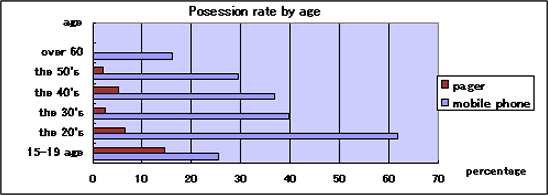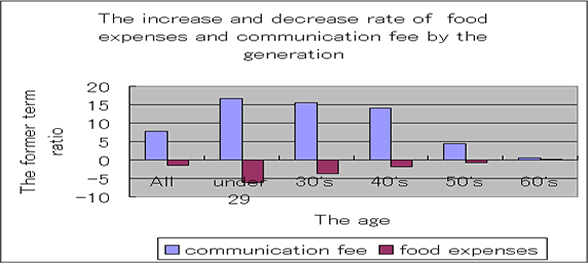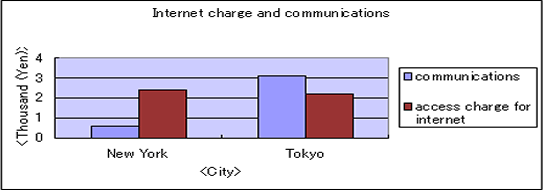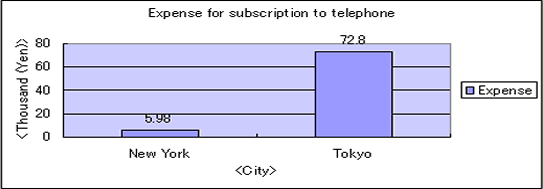Harvard Project

ここでは、2000年度に我々(国際比較ゼミ生・経済ゼミ生からのボランティア生含む)が外国大学(ハーバード大学)の論文を読み、そしてそれに対して日本側からなにか提言・補足はできないかと皆で資料を調べて、最終的に英語の論文を書き上げました。
PDF形式はこちら
|
Harvard Project |

ここでは、2000年度に我々(国際比較ゼミ生・経済ゼミ生からのボランティア生含む)が外国大学(ハーバード大学)の論文を読み、そしてそれに対して日本側からなにか提言・補足はできないかと皆で資料を調べて、最終的に英語の論文を書き上げました。 |
| Preface |
|
This paper is compiled and presented by professor Hiroshi Mochizuki's seminar students. This paper is designed to examine in detail the global effects of the internet on the spread of communication and the current situation derived from this new wave of mass communication in contemporary Japan. Differences in educational systems, national characteristics, and the social foundation all play a significant role in contributing to the information-orientated society in each country. In this paper the remarkable and explosive spread of mobile phones in Japan will be examined, and contrasted with the low computer usage. Why has the more recent mobile technology, rather than the personal computer, been the successful means of Internet communication for young people? To explain this recent phenomena, unique to Japan, we would like to examine how this globalization occurred and how it differs among young people in particular with the US. |
| Chapter 1: Japan lags behind in the computer age |
| Japan
is now faced with the fact that it has lost momentum as leader in advanced
computer technology, and has in fact, fallen behind. A very important factor
to consider is the underlying difference in the need for a PC. When one
compares the rate at which home computer have spread in the US and in Japan.
Statistics show a rate of 32.6% for Japan and 50% for America, with the
rate of Internet usage at 11% for Japan and 37% for America. <graph1>  Although differences in size and structure of communities in the two countries also have to be taken into account when analyzing the rate of spread, several revealing elements have emerged to corroborate this contrast. 1 A large number of Japanese schools do not make use of computers. In fact, the introduction of computers at school is quite recent, with teachers and students taking an active part. since computer skills are not a requirement for the entrance exams, and therefore take a back seat in importance. 2 E-commerce in Japan has not yet caught on users are definitely increasing. But many have doubts about the effectiveness of security. Furthermore there are a lots convenience stores in Japan, so we don't have to use e commerce. <graph2>  3 Another reasons are the difference between Japanese and American education system. For example, Japanese students can turn in hand written report. Some Japanese students don't even want to search for information when we write a report, because they are used to the passive style of education, in which a teacher stands in front of about 40 student, who just take the notes they fall into copy from some books. |
| Chapter 2: Explosive Spread of Mobile Phones |
| Spreading
Process of Mobile Phone While the spread of personal computers has been
delayed, the spread of mobile phones has caught on like wildfire. Here we
would like to examine the process under which mobile phones became so popular.
Firstly, telephones quickly became a household item as communication tool in the background of high economic growth and development of the communications industries. In addition to the telephone as a means of communication, the pager rapidly spread among students around 1994. During this time, means of virtual communication by group-oriented youths came into existence. We should also take notice here that as the popularity of the pager spread, prices came down due to improvement in cost performance. This in turn enabled students to afford buying them on their own. Therefore, up to now, we have not felt the need to advance new means of communicating, as we were able to communicate with anyone, anywhere, and at any time, especially in urgent cases. In addition to the telephone, this new means of communication by using the pager rapidly spread, and finally from the pager to a mobile phone. Mobile phones are more useful than pagers in that there is voice communication on top of word communication. Thus, the mobile phone fits the needs of young people better than pagers. Another determining factor in the growth rate of mobile phone usage is the substantial price reduction. Prices have been reduced to the point where it is easily accessible to the ordinary student. However, the price of a fixed phone is cheaper than the mobile phone. Why does it become so popular among them? Young people doesn't want to be heard their talks to their family. So, they seem that they buy the mobile phone for protecting their privacy. If you look at graphs 3 and 4 that indicates the number of subscribers and basic rate per year, you will notice that in the year 1994 when the mobile phones became popular. SO, subscribers doubled to 4 million and the rate went down to 8 thousand 8 hundred yen, making it4 thousand yen lower than the rate in 1993. <graph3>   We now direct your attention to the fact that mobile phones have replaced pagers as goods. Looking at graph 5, you will notice pagers have started increasing in number of subscribers around 1990, with subscribers to both rapidly increasing from 1994, after that, only subscribers of mobile phone kept increasing, and finally reaching the same level for both in 1995. <graph 5>   Here we can infer the relationship between computers and mobile phones; the mobile phone becomes the compensation of computers. It means that strong demand for mobile phones reflects compensation process for delayed diffusion of computers. In fact, mobile phones began to establish themselves as a strong candidate for driving force for future network society. For another instance graph 7 clearly indicates the rapid substituting process of fixed phones by mobile phones. By 1994, nearly thirty percent of the mobile phones diffused among Japanese society. Declining cost and demand for private conversation on the phones are the main reasons for this explosive diffusion process. <graph 7> |
| Chapter 3: Virtual Communication is Peculiar to Japan |
| The selection of the
mobile phone as a major communication tool by young Japanese is now widespread
in Japan. We should take into account that there is a high percentage of
mobile phone users among Japanese students and a low percentage of its among
American students in their teens and twenties, with the stark difference
being in the nature of their communication. For example, in the case of America, it is mostly for business contacts or information, or for private calls of a personal nature. So, in America mobile phone users are mostly businessmen, not students. In Japan, on the contrary, it is mostly for group social contacts or for private social calls mainly in the area of entertainment. Young Japanese like to have a sense of belonging to a group and they find the mobile phone very useful when interacting within the group. For that reason, if young Japanese does not have access to a mobile phone, he feels very uneasy for having been left out of the group. He heavily relies on the mobile phone to keep in touch with his group and for social networking. Thus, while the young Japanese is active in virtual communication, it is mainly widely scattered and relatively shallows, a speaking acquaintance. This group mentality seen among the young Japanese is thought to be caused by the kind of education system enforced in Japan. School lectures are notoriously one-sided in Japan. The children are required only to listen passively to the teachers giving the lectures. This has an effect of naturally suppressing the student's creative powers and the ability to assert himself. It is a widely shared view that the reason most young Japanese are unable to speak up for themselves and strictly avoid being in the limelight is because they have been trained to be passive in class, otherwise "the nail that sticks out will be hammered in". On the other hand, lectures are a form of discussion and an oral examination in America. To take part in a lecture, you need to contribute your original thoughts to the discussion. Ideas different from others are respected and encouraged, and are thought to be emanating from your personality. A person must be able to express his personality in order to contribute to the exchange of ideas. It shows a strong commitment when this exchange of ideas takes place among people with different and even opposing opinions and ideas. On the other hand, Japanese student's lack the basis needed to develop a sense of commitment in their peer relationships; they associate with friends who all think in the same way, and have a shallow and frivolous association for the most part. The road to better understanding and comprise is still far away. That is the reason why virtual communication in Japan does not require a sense of commitment, and so it remains shallow and superficial. This type of virtual communication is best served by the mobile phone. In fact, there are some interesting data on the views of young Japanese regarding communication costs. |
| Chapter 4: Previous Rate of Cost for Food and Communication |
<table1>
 <graph8>  As you can see from the above chart, the trend in money spent on mobile telephones and the Internet clearly accelerates in the 20- and 30- age bracket. To manage their spending, they cut down on their expenditure of food. The IT revolution moves on steadily among the younger generation. For person who lives oneself, it seems that the mobile telephone and Internet take priority over 3 meals a day. The domestic IT revolution shows a distinct difference in the usage frequency of mobile phones and the Internet between those in their 20's and 30's, and those in their 50's. Looking at it from the amount of money spent, communication costs stand at 10% of food costs. However, those changes are small. In this way, the Japanese younger generation has been instilled the importance and value of virtual communication by direct voice on the mobile phone. This is the reason for its unprecedented growth among the younger generation. Meanwhile, mobile phones in America have not enjoyed the same growth as they did in Japan, mainly because the use of personal computers was already spreading very fast, due to cheap city telephone rates. As charges for inter-city calls are included in the basic fare, internet connection fares are very minimal, in line with inter- city calls. Mobile phones in America are mainly used by business persons that are pressed for time and do not mind the higher costs. But for students, using the mobile phone is too costly and quite unnecessary. Using E-mail via the personal computer for communications with school and among families and friends has been firmly established in America. Using mobile telephones instead is very costly. Another reason for the difference is network dependency. Japanese students have a tendency to prefer direct virtual communication by voice. This is high network dependency. American students are more independent, so they have a lower rate of network dependency, and see little necessity for a mobile phone. Also, there is one more reason that Americans don't possess mobile phones. They have to save money so that they buy a car and pay their tuition. These serve the low spread rate of mobile telephone as a background in America. We feel the findings stated in this paper have helped cast some light into the differences between Japan and America in their use of communication tools and methods of communication. |
| Chapter 5: Problems in Communication Charges between Japan and America |
| Presently serious
problems have occurred between Japan and the U.S. regarding communication
fees. This problem has arisen because of the difference in inside and outside
price between the two countries; Japan's communications (for example, access
charge for internet) is higher than America. The side insisting on settling
this problem, communication fees, is America. Looking at the figures, then
you would realize easily that Japanese telephone charges exceed those in
America in all cases. <graph 9>  <graph  <graph  However, the extent to which Japanese telephone charges exceed those in America is strikingly apparent in the charges for the usage of the Internet. Here, the Japanese market is being too exclusive; Japanese market is too closed for outsider to participate in. Specifically NTT's management condition, the biggest telecommunication company in Japan, is the one of the reasons why Japanese market is so closed. Japanese government had regulated NTT for a long time so that NTT couldn't purvey the goods by themselves. But now, NTT is planning to purvey the materials, for production, themselves from now on. Because if regulation would still be left to the Japan's Government, NTT would be unable to respond to the subscriber's requests that demanding lower price and more convenient. As for the American side, they insist that NTT would refrain to purvey foreign goods, especially American goods. The reason why the U.S. criticizing for NTT is this; the U.S. is afraid of discrimination from inside as well as outside, for example NTT would only purvey Japan's goods, and the chances of market monopolization by NTT, would happen. Therefore another trade friction between America and Japan is likely to happen because of this. As to the supply of materials, the prefectures of both administrations have come to a mutual accord after close examination of the conditions set forth for carrying out this agreement. Regarding interconnection fees for the Internet, however, America insists on having telephone charges reduced by Japan. Their insistence is directed primarily toward NTT. Despite the fact that NTT has not reduced those charges, subscribers are steadily increasing every year. Because of this trend, the monopolization of the market by NTT is highly probable, and as a result, the market will lose any competitiveness it has. This blow to the Japanese economy will undoubtedly have worldwide repercussions. Against America's insistence, Japan maintained a reduction of 16.7% in rates within four years in order to avoid inflicting damage on NTT. But America was not satisfied with this, and although Japan has unwillingly agreed to reduce further to 22.5%, America is demanding a deeper cut. Although this deadlock in telecommunication trade talks between Japan and America continues, both countries have agreed to stage another round of high-level talks in March. While the rate of computers that are hooked up to internet is only 11 percent, diffusion rate of mobile phones have already reached to more than 40 percent in Japan. This figure suggests that mobile terminal based networking has higher potential for future network society than personal computer based networking. Facing with this unusual situation, NTT, the biggest Telecommunication Company in Japan, seems to have an ambitious plan to make handy terminal the critical device for network society by changing mobile phones into mobile terminal. At present there exists two competing mobile terminal standards in Japan. They are "i mode" of NTT and "WAP" of IDO and DDI group. Since an introduction of "i mode", its amazingly fast penetration into market made NTT's server temporarily down. The unique point of "i mode" is in its original communication protocol, which is different from TCP/IP, global standard of internet communication. However, since it utilizes the html language, the current contents of Internet can easily be brought into "i mode." On the other hand, while "WAP" 's protocol is similar to TCP/IP, it does not support html language. We do not yet know which standard will take the top share on the mobile terminal market in the future. However, we are very sure that the mobile terminal will be the main device for promoting the Japanese network society. |
| Chapter 6: Conclusion |
| As we discussed so
far, the mobile telephone is widely chosen as a main device for communication
by the younger generation who is responsible for the Japanese future and
its proliferation is quite evident. One of the main reasons why mobile telephones
are chosen widely is that the mobile telephone is better suited for needs
of group-oriented and virtual communications by the younger generation than
the personal computer. Another reason is simply delayed diffusion of personal
computers in educational process. There is no custom of using computers
before, so until now, many Japanese people including young generation still
can't use computer. We call this "keyboard allergy". Thus, this environment
makes computer's establishment into society slow. Therefore, some critical
roles such as email which personal computer should take has been delegated
to the mobile phone because Japanese people wouldn't feel uncomfortable
than using computers. However, will mobile phone continue to diffuse in
the future? In order to answer this question we should first check the planned
introduction of new information processing education system. With an intention of promoting informatization Ministry of Education has recently revealed a new curriculum for senior high school that requires two credits for "Information Processing" starting from 2003 fiscal year. However, since the entrance examination to the college or university in Japan usually does not necessary include the topic of information processing, the high school teacher is in general reluctant to allocate the very limited time to the computer education. At the same time, high school students do not wish to spend much time on learning unnecessary subjects for entrance examinations. Hence, we have a great deal of doubt about the anticipated achievements. Rather, we propose more fundamental change in educational system including a fundamental reform of college/university entrance examination. Now we reach the point where we should state our final conclusion of this paper. That is, Japan will follow its own approach to the future information society. As a result of the changing character of mobile phones from a simple voice communication tool to an information-processing device, we will be able to expect new and realistic possibility of using mobile phone as nuclei of driving force for promoting information society. Some people may argue that such a handy mobile terminal will help ease those people's mind who feel uncomfortable in handling personal computer. While the functionality of mobile terminal may far less than that of personal computer, it could not be a substitute of personal computer. Hence we believe that mobile handy terminals and personal computers will establish themselves as main driving forces of the future information society by complimentarily supporting each other. |
|
Reference data and home pages |
| 1.2.3.4.5.6.8.9.10.11 http://www.mpt.go.jp/policyreports/japanese/papers/99wp/html/ http://www.mpt.go.jp/pressrelease/japanese/denki/ http://www.mtp.go.jp/policyreports/japanese/stats/handy-phone.html/ 7. Nikkei-newspaper.Tokyo.1999. |
Index>Harvard Project